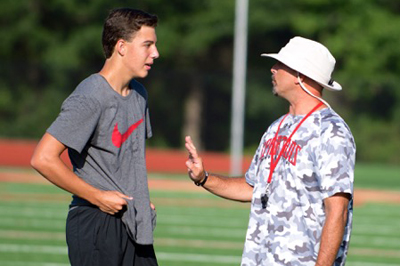Aug 4, 2017Using Metrics, Part Three
To read Part One, please click here.
To read Part Two, please click here.
In our second year of using sports science at at Greater Atlanta Christian School in Norcross, Ga, we have added width by expanding our scope in some areas and branching out into new ones. Here’s a look at the progress we’ve made in year two:
Sleep: Not only have we continued to monitor both the quantity and quality of athletes’ sleep, but we’ve also created a sleep process for them to follow. It consists of creating a sleep ritual, making their bedroom cold and dark, using white noise, turning off their cell phone, sticking to a schedule, and meditating before bed for 10 to 15 minutes.
We advocate for naps, too. Athletes are advised to drink a small amount of caffeine when they get home from school and then sleep for 20 to 30 minutes. The caffeine will take effect when they wake up and keep them from feeling groggy.

Nutrition: We have expanded our tracking by having our more advanced athletes record their total calories consumed daily. They then compare this number to their overall calorie and protein calorie consumption goals in the MyFitnessPal app. In addition, all of our athletes participate in a nutrition education program driven by the NutraCarina platform, which was created by Mike Bewley, MA, CSCS, SSN, USAW-I, Assistant Director of Strength and Conditioning at Georgia Tech.
Stress (academic): According to research done by Bryan Mann, PhD, CSCS, Assistant Director of Strength and Conditioning at the University of Missouri, high academic stress weeks like midterms and finals have nearly twice the injury risk as low academic stress weeks. We monitor all stress levels closely during these high-risk periods using the rate of perceived exertion (RPE) scale. Athletes rank their level of stress from one to five, with five being the highest. When athletes are under a lot of stress, we’ll reduce volume in the weightroom and decrease our use of technical exercises, if possible.
Stress (personal): Home life, family, parents, friends, teachers, classes, and many other outside influences can derail an athlete’s training cycle by increasing positive or negative stress loads. Therefore, we attempt to collect data on personal stress through a modified RPE scale. We don’t ask specific questions about what’s causing increased personal stress. Rather, we use the RPE results as an opportunity to connect with the athlete and see what we can do to provide relief.
Readiness: New to the overall scoring system is the concept of readiness built around resting heart rate. Utilizing the Polar Team 2 System, we have begun collecting athletes’ resting heart rates, max heart rates, and time spent in different heart rate zones during training. For recovery and regeneration, we have also been recording athletes’ resting heart rates upon waking, as well as their one-minute heart rate recovery following a maximal bout of training. This information gives us a general idea of how well their nervous system has recovered from the previous day’s and week’s stress.
Two other new elements to our work with readiness are heart rate variability (HRV) and reactive strength index. Our goal is to see whether monitoring these two traits is applicable to training.
HRV is the change in the rhythm of the heart as the result of training. Generally speaking, more variability between a heartbeat is indicative of a cardiovascular system that is ready to perform, while less variability indicates a greater degree of fatigue and potential incomplete recovery. We’ve been experimenting with Firstbeat and Bioforce HRV to track this metric.
To determine a reactive strength index, we have athletes drop from a height onto a contact mat or force platform and perform a max-effort vertical jump. The result is an indicator of how well they have recovered from previous explosive training.
Strength response: We utilize TeamBuildr strength and conditioning software to manage our daily workloads. Each athlete’s training volume is monitored daily, and workout completion, total training load, and overall volume are charted to note any low levels of performance.
Although we’ve had a great deal of success incorporating technology and advanced metrics at GACS, it must be clearly stated that data analysis alone does not determine our programming. Science without art is not coaching. There are many factors that go into making modifications to a training program, and we use all available tools to maximize athlete development.



